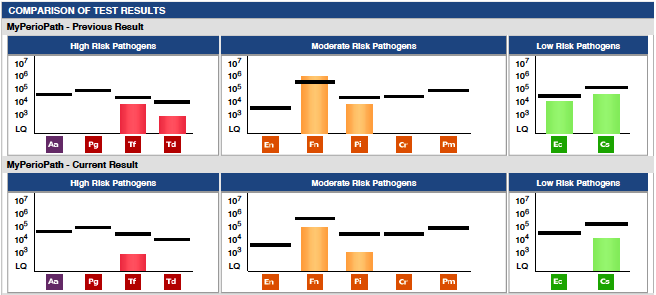
Challenge: The patient is expressing oral inflammation and is pregnant. The clinical signs of periodontal disease due to pathogenic bacteria look identical to the clinical signs produced by pregnancy hormones.
Background: A 21-week pregnant patient, age 34, presented for care. Upon periodontal assessment, there was generalized marginal inflammation with moderate bleeding on probing. The probe depth readings were generalized 3-4mm. The patient’s oral homecare consisted of twice daily brushing with occasional flossing. A complete review of the medical history revealed no other significant findings, including no history of tobacco use.
Solution: A MyPerioPath® was collected 6/14/2018 to determine if there was a bacterial cause for the inflammation. Same day therapy was administered which included an adult prophy with debridement above and below the gum line, irrigation with chlorhexidine and periodontal laser therapy with a Sirolaser 970nm, 320 micron fiber, 1.8 watts, duty cycle 50% at 0.9 Hz, power level 10 watts. The MyPerioPath® results on 6/19/2018, revealed significant levels of periodontal pathogens, especially Fusobacteriam nucleatum. As there is evidence to show that this bacterium can complicate pregnancies, the patient was instructed to begin a course of Metronizadole 500 mg bid for 8-10 days. The patient was scheduled for continued maintenance and evaluation of therapy on 10/30/2018.
Resolution: The patient, still pregnant, returned on 9/26/2018 for adult prophylaxis. The clinical improvements included generalized knife-edge margins with localize light bleeding on scaling. The patient reported that she had started to floss daily and brush 2 x per day. When asked about taking the systemic antibiotic, the patient stated that she did not take the Metronidazole, as she was apprehensive due to pregnancy.
A post MyPerioPath®, aka MyPerioProgress®, was collected post-partum 10/31/2018. The results revealed a dramatic reduction of pathogen load by 43% with Td below the limit of quantification, Tf reduced by 1 logs, and Fn reduced 2 logs. It was decided to wait and secure the specimen post-partum because I wanted to see the change in pathogen load after delivery.

For more information on how to become an OralDNA Provider – scan HERE: 
- Periodontal Disease & Pregnancy - May 10, 2019
